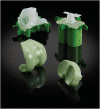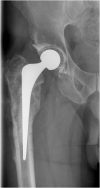Articular spacers in two-stage revision arthroplasty for prosthetic joint infection of the hip and the knee
- PMID: 35192512
- PMCID: PMC8897569
- DOI: 10.1530/EOR-21-0037
Articular spacers in two-stage revision arthroplasty for prosthetic joint infection of the hip and the knee
Abstract
Use of articular antibiotic-eluting cement spacers during two-stage revision arthroplasty for prosthetic joint infection (PJI) is a long-established and proven adjunctive technique during first-stage surgery. Articular spacers come in many forms, either static or dynamic. The authors present an instructional review of current evidence regarding their use. A total of 45 studies (for spacer use in PJI involving either hip or knee) were analysed for data regarding eradication rate, functional outcomes, mechanical complications and the impact on second-stage surgery. A large number of case series and retrospective cohort studies were retrieved, with only a small number of prospective studies (2). High levels of infection eradication were commonly reported (>80%). Outcome scores were commonly reported as indicating good-to-excellent function and pain levels. Second-stage procedures were often not required when dynamic spacers were used. Static spacers were associated with more mechanical complications in both the hip and the knee. In the hip, dynamic spacers were more commonly associated with instability compared to static spacers. Consideration should be given to the use of dual-mobility or constrained definitive acetabular components in these cases at second-stage surgery. The use of antibiotic-eluting polymethylmethacrylate articular spacers in two-stage revision for PJI of hip and knee arthroplasty achieves a high rate of infection eradication. Dynamic spacers may confer a variety of benefits compared to static spacers, with a similar rate of infection eradication.
Keywords: intra-articular spacer; prosthetic joint infection; revision arthroplasty.
Figures










References
-
- Callahan CM, Drake BG, Heck DA, Dittus RS. Patient outcomes following tricompartmental total knee replacement. A meta-analysis. JAMA 19942711349–1357. - PubMed
-
- Klem N-R, Kent P, Smith A, Dowsey M, Fary R, Schütze R, O’Sullivan P, Choong P, Bunzli S. Satisfaction after total knee replacement for osteoarthritis is usually high, but what are we measuring? A systematic review. Osteoarthritis and Cartilage Open 202021000, 32. (10.1016/j.ocarto.2020.100032:100032) - DOI - PMC - PubMed
Publication types
LinkOut - more resources
Full Text Sources

